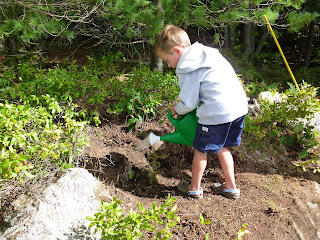Why do we need clouds to give us rain?
"So they can rain on trees so they can grow." - J.S.
"To make flowers grow." - R.F.
"We need water to grow and an umbrella to keep us dry." - T.B.
"The birds need to drink water." - L.D.
"Animals need to drink too." - A.M.
How do clouds make rain?
"They rain when they want." - S.M.
"When clouds get dark that means it's going to rain." - L.D.
"The clouds all come together to make rain." - I.D.
"First one cloud gets the rain and then brings it to the sun and then gives it to the other cloud." - L.D.
"The clouds go over each other and they turn into a big black pad." - W.V.
"The clouds get the water from the splash-pads." - T.B.
"The clouds get the water from the ocean to make rain." - L.D.
 After listening to our students fascinating propositions, we decided to introduce the water cycle with a read-aloud. "The Falling Raindrop" by Neil Johnson and Joel Chin was given to me as a gift by my mentor Tania Sterling (@taniasterling / www.taniasterling.wordpress.com) and is a wonderful book that not only illustrates and teaches the water cycle in simple terms, but it also is one that has a deeper message of creating a positive climate for learning. After reading the story, we had our students become the raindrop and use their bodies to retell what happened to him (with our prompting) throughout the story. This dramatic representation of the water cycle helped our students understand the four simple steps to creating rain and was the perfect precursor to our experiment! Coupling this kinesthetic approach with a diagram, our students were able to remember what happens when a raindrop is born and how it becomes a cloud again.
After listening to our students fascinating propositions, we decided to introduce the water cycle with a read-aloud. "The Falling Raindrop" by Neil Johnson and Joel Chin was given to me as a gift by my mentor Tania Sterling (@taniasterling / www.taniasterling.wordpress.com) and is a wonderful book that not only illustrates and teaches the water cycle in simple terms, but it also is one that has a deeper message of creating a positive climate for learning. After reading the story, we had our students become the raindrop and use their bodies to retell what happened to him (with our prompting) throughout the story. This dramatic representation of the water cycle helped our students understand the four simple steps to creating rain and was the perfect precursor to our experiment! Coupling this kinesthetic approach with a diagram, our students were able to remember what happens when a raindrop is born and how it becomes a cloud again.
Keeping in mind that all this learning took place over the course of the week and is still ongoing, we decided to celebrate our learning about the water cycle with an experiment! We were going to illustrate our theories about how a cloud makes rain by making rain ourselves! Our students were thrilled and fully embraced the role of becoming scientists by remembering that scientists needed "magnifying glasses to look at things, a camera to take pictures, a clipboard to write stuff down, a pencil to write our words, and a marker to draw pictures." After setting up the learning space for this experiment and creating a "Materials" list with our student scientists, we modelled how to complete the Experiment chart. Next, we took estimates as a class as to how many raindrops our cotton ball clouds could hold before they started to make rain! Estimates ranged from 10 drops to 100 and students were very eager and excited to test their theories!
Each group had: 1 baking tray, 1 jar, 1 cotton ball, 1 eye dropper, 1-3 magnifying glasses, 1 cup of water, markers and an Experiment Chart
As a Rain Team, our students scientists worked in small groups of 3-4 to see how many raindrops their cotton ball cloud could hold before it started to rain into their jar.
Using our "rain water" (water with blue food colouring), students took turns with the eyedropper as they dripped rain onto their cloud. Using magnifying glasses, other members of their group watched closely to see if and when a rain drop would fall.
My DECE and I circulated amongst all the groups with a clipboard, camera, and pencil in hand documenting their conversations and discoveries! We were amazed to see how focused and collaborative our student scientists were as they worked together to complete the experiment and fill out their Experiment chart. One group shouted out "Our cloud is making rain!" and another "We see rain dripping in our jar!" - it was all very exciting!
To consolidate our learning, we had our class meet back in a community circle:
What did you see during your experiment?
"We saw raindrops and some clouds." - I.D.
"First [the cotton ball cloud] was white and then it turned blue. [The cloud] was dark blue and then we squeezed it and it became light blue." - S.M.
"We squeezed the eyedropper on the cotton ball and then the rain came!" - I.D.
"We put the water in the glass and it makes rain." - V.D.
"[The cloud] looked heavy and blue." - R.L.
"[The cloud] couldn't hold anymore water so it started to rain." - T.L.
How many drops did it take for your cloud to make rain?
"26!" "83!" "16!" were some of the groups findings!
All in all, our experiment brought together science, peer learning and inquiry and it was huge success! Our students continue to talk about it and we look forward to venturing more into the science behind clouds and trying more experiments in the near future! Stay tuned!











































